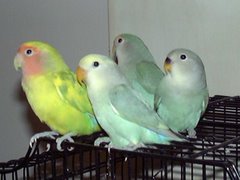Brooding in Lovebirds
Brooding is a natural behavior exhibited by lovebirds, particularly the females, when they are preparing to lay eggs and incubate them. During this time, the female lovebird will spend long periods of time sitting on her eggs to keep them warm and ensure proper development. The male lovebird will often assist with the brooding process by bringing food to the female and taking turns sitting on the eggs.
Lovebirds typically lay between four to six eggs, which will hatch after approximately 23 days of incubation. During this time, the female will rarely leave the nest, and the male will continue to bring food and other materials to the nest to support the breeding pair.
It's important for lovebird owners to provide their pets with a suitable nesting box and a quiet, peaceful environment during the brooding period to ensure a successful hatching and healthy chicks.









 Free Ads For Bloggers
Free Ads For Bloggers

